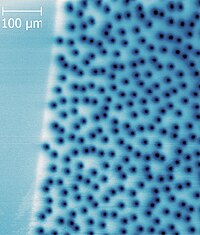Abrikosov vortex

Okay kiddo, let's dive into the world of Abrikosov vortex, which is quite fascinating! Abrikosov vortex refers to a unique situation that occurs in superconductors (a special type of material which has zero electrical resistance when cooled below a certain temperature). When a superconductor is cooled down to its critical temperature, it's like a big party with lots of guests (electrons), all moving and bouncing around randomly.
Now, imagine that some of those guests (electrons) start to get too close to each other, forming a repelling force that pushes them outward. These electrons may end up stuck in the middle of the superconductor, unable to move away from each other. This forms a sort of whirlpool, like what you might see in a bathtub, and we call it a vortex.
But here's the twist, this vortex is not just any average whirlpool. This vortex is in a superconductor, which, as we mentioned, has zero electrical resistance. So, if any more electrons try to fly through this superconductor, they will be forced to go around the vortex- it's like a traffic jam. This is the Abrikosov vortex, and it can have an interesting effect on the magnetic field surrounding the superconductor.
So, when a magnetic field is applied to the superconductor, the electrons in the superconductor circulate around this magnetic field forming vortices. Inside each vortex, there is no magnetic field. The magnetic field gets crowded outside the vortex until it becomes so strong that it can push the vortices together into a kind of lattice pattern. This is called a vortex lattice or Abrikosov lattice.
The formation of Abrikosov lattices is a fascinating and complex phenomenon. Scientists are still trying to find out more about it, but the vortex and vortex lattice structures have a significant impact on the electrical and magnetic properties of superconductors.
Now, imagine that some of those guests (electrons) start to get too close to each other, forming a repelling force that pushes them outward. These electrons may end up stuck in the middle of the superconductor, unable to move away from each other. This forms a sort of whirlpool, like what you might see in a bathtub, and we call it a vortex.
But here's the twist, this vortex is not just any average whirlpool. This vortex is in a superconductor, which, as we mentioned, has zero electrical resistance. So, if any more electrons try to fly through this superconductor, they will be forced to go around the vortex- it's like a traffic jam. This is the Abrikosov vortex, and it can have an interesting effect on the magnetic field surrounding the superconductor.
So, when a magnetic field is applied to the superconductor, the electrons in the superconductor circulate around this magnetic field forming vortices. Inside each vortex, there is no magnetic field. The magnetic field gets crowded outside the vortex until it becomes so strong that it can push the vortices together into a kind of lattice pattern. This is called a vortex lattice or Abrikosov lattice.
The formation of Abrikosov lattices is a fascinating and complex phenomenon. Scientists are still trying to find out more about it, but the vortex and vortex lattice structures have a significant impact on the electrical and magnetic properties of superconductors.
Related topics others have asked about:
